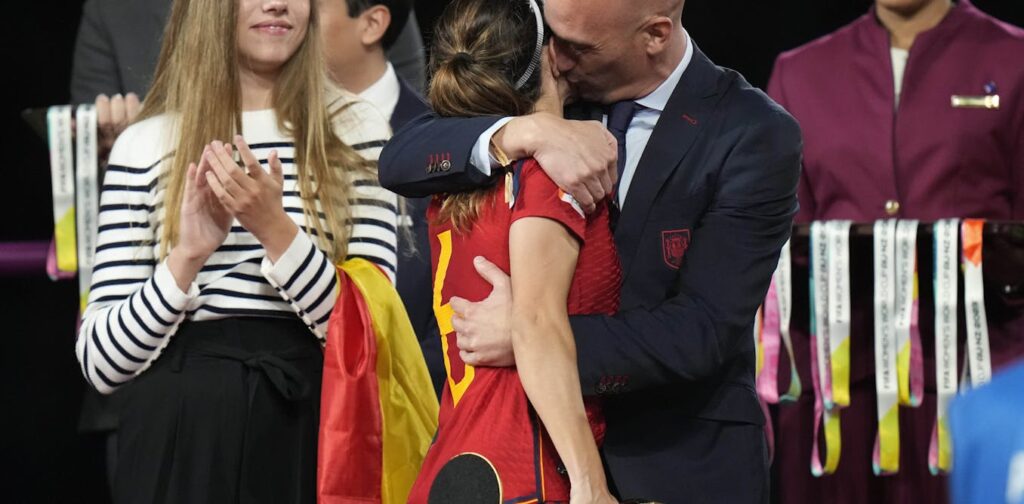Former Spanish Football Federation president Luis Rubiales may face serious consequences for his non-consensual kiss with Spanish soccer player Jenni Hermoso.
However, this is not the norm for perpetrators of gender-based violence in sports. Our study, which reviewed 25 years of research examining women's experiences of gender-based violence in sport, found that perpetrators are rarely held accountable.
More commonly, they are free to continue abusing their victims with impunity.
that even after millions of people monitored Ms. Rubiales' actions, Ms. Hermoso's experience was downplayed and powerful organizations tried to coerce her into claiming it was consensual; , it was clear that it took the collective voice of women standing by Hermoso to fight back loudly. “no”.
The shocking reality of gender-based violence in sports
Although women's sport is championed as a foundation for empowerment and equality, previous research has shown that gender-based violence is highly prevalent, with psychological, physical, and sexual violence depending on how violence is defined and measured. It has been shown to account for 26-75% of all violence.
There have been many incidents of abuse, both historical and contemporary, that have revealed some of the concerns of how perpetrators were able to continue their abuse for so long.
Our research systematically collected and analyzed the voices of women who have experienced gender-based violence in sport to better understand their experiences and inform future prevention and response efforts. Participants included current and former athletes, coaches, referees, and managers.
The study found that women in sports experience multiple types of violence (sexual, physical, psychological, and economic), often perpetrated by multiple perpetrators. . The most common perpetrators are coaches and other authority figures, followed by male athletes and the general public.
We found a 'normalization' of these acts of violence in the context of sport. They were seen as expected and routinely tolerated in order to get results.
Read more: Another incident of abuse in elite sport, so why are we still waiting to protect New Zealand sportswomen from harm?
Please be careful about “sports domestic violence”
When women do speak up and complain, our research highlights that organizational responses can be ineffective at best and actively malicious and cruel at worst.
Complaints often go nowhere, there are sometimes no codes of conduct, and there is a severe lack of confidentiality as “everyone knows everyone”.
In some cases, women were ridiculed and told that they had imagined abuse, a deliberate strategy by an organization that prioritized “success” and “victory” over women's safety.
Instead, women must strive for their own safety by avoiding the perpetrator or leaving the sport altogether.
Justice can only be achieved if women act as a group to voice their experiences and confront their abusers.
Importantly, our research reveals a sports-specific situation in which extended families and surrogate families create conditions for “sports family violence.”
Athletes spend a lot of time in their sports family unit and develop close relationships with coaches, other authority figures, and teammates.
coach like father
Coaches as fathers were a consistent theme in several studies, with some athletes stating that their coaches knew them better than their parents.
When a coach is considered “the best”, often no one questions him. This gave coaches great power, which they used to isolate the women they abused from both their athletic and real families, and exercise coercive control to maintain an environment of secrecy and control. .
Finally, our research found that women are still considered inferior to men and treated as “others” in the context of sport. As a result, there is hostility towards women who are perceived as a threat to the hegemonic masculinity of sport.
This was a particularly strong theme for women in non-traditional women's sports, such as judo and boxing, and for women in management and public positions.
Power is a key element running through all of our findings, and while women may be able to exercise some power through collective resistance, power is often vested in colluding men and sports organizations. Remaining.
Efforts to address gender-based violence in sport must recognize the different forms of violence experienced by women and the different ways in which power and violence play out.
Read more: Toxic sports culture is damaging the health of female athletes, but we can do better
There are some bright spots, but more needs to be done
There are some positive signs of change. A recent report into the culture of abuse in Australian swimming set out several recommendations that are currently being implemented.
And in the UK, laws have been developed and enforced that prohibit coaches from having relationships with players.
Several collective survivor advocacy groups have also been established, including The Army of Survivors, Sport and Rights Alliance, and Gymnasts for Change.
Of course, this still shows the range of collective voices needed to drive change.
While we applaud this and Rubiales' reckoning with her actions, and support the collective voice that stands with women like Jenni Hermoso, we also acknowledge the brunt of violence within spaces often thought of as our own. It would be remiss of us to forget the voices of the many women who have been silenced in the sports world. family.


